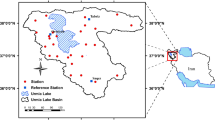Abstract
The distribution of potential evaporation is highly unstable due to complex human activities and climate changes. Therefore, it is of great significance for further understanding hydrological cycle to estimate potential evaporation distribution. Reasonable regionalization of potential evaporation will help to improve the efficiency of irrigation and increase the ability of drought relief, which is of great importance to irrigation planning and management. Hence, the spatio-temporal changes in potential evaporation distribution at monthly and annual scales are investigated based on the modified Mann-Kendall trend test method and the entropy theory in the Wei River Basin. A nonparametric method as an attractive alternative to empirical and parametric approaches is proposed to calculate the univariate and bivariate probability distribution of potential evaporation. The directional information transfer index (DITI) is employed to estimate the similarity among the meteorological stations, and the k-means cluster analysis is used to classify the meteorological stations into several distribution zones with distinct features. Based on the monthly potential evaporation from 1960 to 2008 at 21 meteorological stations, the basin is ultimately classified into 8 zones with their own distinct spatio-temporal distribution features. In view of the distinct spatio-temporal distribution features, the DITI-based model combined with the nonparametric probability estimation method and the k-means cluster analysis offers a more precise classification of potential evaporation distribution zones.








Similar content being viewed by others
References
Adamowski K (1996) Nonparametric estimation of low-flow frequencies. J Hydraul Eng 122(1):46–49
Ahmed ES, Ali N, Humod MA, Heerbod J (2014) Optimized neural network prediction model for potential evapotranspiration utilizing ensemble procedure. Water Resour Manag 28(4):947–967
Amorocho J, Espidora B (1973) Entropy in the assessment of uncertainty in hydrologic systems and models. Water Resour Res 9:1511–1522
Brutsaert WH (1982) Evaporation into the atmosphere. D. Reidel Publishing Company, Dordrecht
Chauhan S, Shrivastava RK (2008) Performance evaluation of reference evapotranspiration estimation using climate based methods and artificial neural networks. Water Resour Manag 23:825–837
Cox DR, Isham V (1994) Stochastic models of precipitation. In: Barnet V, Turkman KF (eds) Statistics for the environment 2: water related issues. Wiley, New York, pp 3–18
Dunn JC (1974) A fuzzy relative of the ISODATA process and its use in detecting compact well separated clusters. J Cybern 3(3):32–57
Hamed KH, Rao AR (1998) A modified Mann–Kendall trend test forauto correlated data. J Hydrol 204:182–196
Harrell FE, Davis CE (1982) A new distribution free quantile estimator. Biometrika 693:635–640
Jackson RD (1985) Evaluating evapotranspiration at local and regional scales. Proc IEEE 73(6):1086–1096
Kagan AM, Linnik YV, Rao CR (1973) Characterization problems in mathematical statistics. Wiley, New York
Kendall MG (1955) Rank correlation methods. Griffin, London
Kim TW, Juan BV, Yoo C (2003) Nonparametric approach for estimating return periods of droughts in arid regions. J Hydrol Eng 8:237–246
Liu Q, McVicar TR (2012) Assessing climate change induced modification of Penman potential evaporation and runoff sensitivity in a large water-limited basin. J Hydrol 464–465:352–362
Liu BJ, Chen XH, Lian YQ et al (2013) Entropy-based assessment and zoning of rainfall distribution. J Hydrol 490:32–40
Mann HB (1945) Nonparametric tests against trend. Econometrica 13:245–259
Mishra AK, Özger M, Singh VP (2009) An entropy-based investigation into the variability of precipitation. J Hydrol 370:139–154
Monin AS, Obukhov AB (1954) Basic turbulent mixing laws in the atmospheric surface layer. Trudy Geofiz Inst Akad Nauk SSSR 24:163–187
Monteith JL (1965) Evaporation and environment. Symp Soc Exp Biol 19:205–234
Moon Y, Lall U (1994) Kernel quantile function estimator for flood frequency analysis. Water Resour Res 30(11):3095–3103
Rahimikhoob A, Behbahani M, Fakheri J (2012) An evaluation of four reference evapotranspiration models in a subtropical climate. Water Resour Manag 26(10):2867–2881
Rozumalski A, Schwarz MH (2009) Crouch gait patterns defined using k-means cluster analysis are related to underlying clinical pathology. Gait Posture 30:155–160
Sadri S, Burn DH (2012) Nonparametric methods for drought severity estimation at ungauged sites. Water Resour Res 48, W12505
Shannon CE (1948) A mathematical theory of communication. Bell Syst Tech J XXVII:379–423,623–656
Sharma A (2000) Seasonal to interseasonal rainfall probabilistic forecasts for improved water supply management: part 3—a nonparametric probabilistic forecast model. J Hydrol 239:249–258
Singh VP, Deng ZQ (2003) Entropy-based parameter estimation for Kappa Distribution. J Hydrol Eng 8(2):81–92
Singh VP, Fiorentino M (1992) A historical perspective of entropy applications in water resources. In: Entropy and energy dissipation in water resources. Kluwer Academic Publishers, pp 153–173
Zhang H, Chen Y, Ren G, Yang G (2008) The characteristics of precipitation variation of Weihe River Basin in Shaanxi Province during recent 50 years. Agric Res Arid Areas 26(4):236–242 (in Chinese)
Zhang Q, Singh VP, Peng JT et al (2012) Spatial–temporal changes of precipitation structure across the Pearl River basin, China. J Hydrol 440–441:113–122
Acknowledgments
This research was supported by the National natural science foundation of key projects (51190093), the National Major Fundamental Research Program, 973 (2011CB403306-2), the Natural Science Foundation of China (51179149, 51179149, 51309098), the Non-profit Industry Financial Program of MWR (201301039), the Ministry of Education in the new century talents program (NCET-10-0933) and the Key Innovation Group of Science and Technology of Shaanxi (2012KCT-10). Sincere gratitude is extended to the editor and the anonymous reviewers for their professional comments and corrections, which greatly improved the presentation of the paper.
Author information
Authors and Affiliations
Corresponding author
Rights and permissions
About this article
Cite this article
Huang, S., Chang, J., Huang, Q. et al. Spatio-Temporal Changes in Potential Evaporation Based on Entropy Across the Wei River Basin. Water Resour Manage 28, 4599–4613 (2014). https://doi.org/10.1007/s11269-014-0760-6
Received:
Accepted:
Published:
Issue Date:
DOI: https://doi.org/10.1007/s11269-014-0760-6




